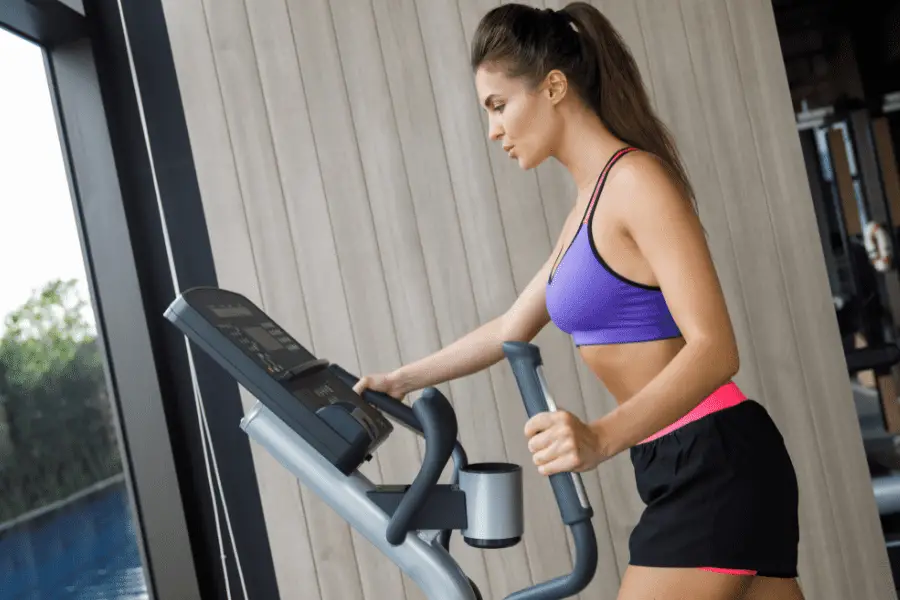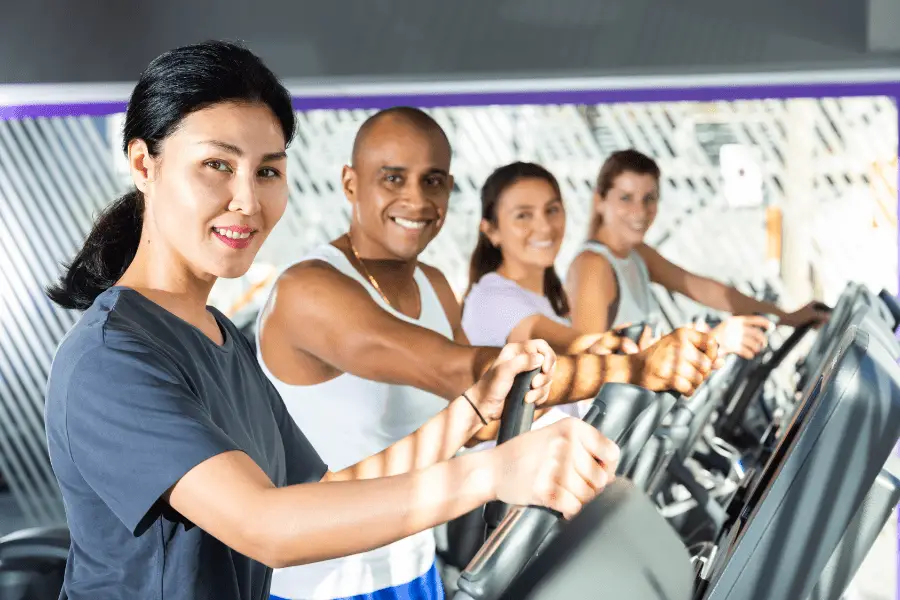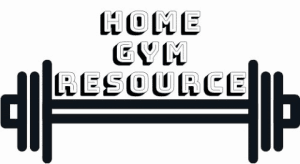Ellipticals are great machines for staying in shape and burning calories in a short amount of time. But is 10 minutes a day enough to see any results in health and weight?
30 minutes of exercise a day/5 days a week is the minimum recommended amount of exercise. Using an elliptical for 10 minutes can burn an average of 100 calories per session (weight and speed-dependent). HIIT might allow you to burn more calories in 10 minutes as well as have more health benefits.
Understanding how long you should use an elliptical at a time and what kind of results you can get depends on a number of things.
Contents
What Does 10 Minutes On An Elliptical Do?
10 minutes on an elliptical is not a lot. Your body will barely be warmed up at that point. If we assume 10 minutes of work at high speed and intensity, you’ll burn at most 100 calories. At moderate intensity, it will be around 75 calories.
This is not enough to notice any weight loss unless you’re also in a calorie deficit through your diet. A pound of fat contains about 3500 calories worth of energy so 100 calories a day isn’t going to add a whole lot of speed to your weight loss if you’re eating exactly enough to maintain weight.
For health and performance, 10 minutes is not really enough to do anything either. 30 minutes a day/5 days a week of moderate exercise is the minimum recommended amount of exercise for heart health. And that’s on top of your normal movements during the day.

If 10 minutes is all you can do now, see if you can decrease the speed and/or resistance on the elliptical. It’s better to do 30 minutes at a lighter resistance level than what you can handle for 10 minutes. Wear a heart rate monitor to make sure you pace yourself. Staying within the right heart rate range will help you optimize the duration and calorie burning.
If 10 minutes is really all you can do at the moment, that’s where you have to start. In that case, don’t expect too much weight loss at first. You have to build up your health and fitness to a point where you can do at least 30 minutes in one workout. This can take a while. Give yourself some time, just be consistent and add a few minutes to every workout. You’ll have to push yourself a little further every time but don’t go too crazy all at once. Adding 5 minutes to every workout is a good target.
10 minute workouts on an elliptical are a place to start but it should be a starting point on the way to better health, endurance, and performance.
If you only have 10 minutes and absolutely can’t free up any more time, look into High-Intensity Interval Training. This is not a beginner workout and can be tough. It’s much tougher to do this than steady-state cardio (constant heart rate) which burns more calories in 10 minutes. It also has a bigger impact on conditioning. For weight loss, longer but lower-intensity workouts are better but if you’re limited by time, it’s the best option.
Got more time? Find out here what 45 minutes on an elliptical can do for you.
How Do Ellipticals Burn Calories?
The more you weigh, the more calories you will burn during an exercise. More specifically, the greater your muscle mass, the quicker you will burn calories. This is because muscle has a greater metabolism rate than fat tissue.
Regardless of your size, the longer and the higher intensity of your workout, the more calories you will burn. You can increase the intensity of your elliptical workout by choosing a greater resistance level, moving at a faster pace, and including intervals of vigorous motion.
Elliptical trainers are great for steady-state cardio but also for High-Intensity Interval Training (HIIT) This is a great way to burn more calories in a short period and also improve your cardiovascular health. A good interval timer is going to make HIIT workouts much more enjoyable. Check out the GymNext Flex timer. It’s super easy to set up and control contrary to most other interval timers making the setup for any workout a breeze.
That being said, if you are not in a position to do high-intensity sessions on the elliptical, you can get the same results as a high-intensity workout by doing a low-intensity workout for a longer amount of time. As long as you are continuously moving, you will burn calories. In that way, you can keep going at any speed with any resistance level that you want until you have burned the number of calories you desire.
Elliptical machines will calculate the number of calories that you are burning automatically. To make sure this number is accurate, you need to input your weight before exercising. Otherwise, the machine will use a predetermined average weight which will most likely not be correct for you.
“According to the Harvard Medical School, you burn approximately 2.16 calories for every pound of body weight during 30 minutes of elliptical use.”
(Source)
Find a good home gym elliptical for a reasonable price here
How Often Should You Use An Elliptical?
Ellipticals are a great alternative to using a treadmill if you suffer from joint injuries. This is a low-impact machine, so you will be less likely to aggravate an injury or hurt your joints to begin with. Since it is nicer on your body than traditional running, it is safe to use the elliptical more often.
You can use the elliptical every day if you desire. However, adults are recommended to exercise at least 150 minutes a week. Typically, this recommendation is broken up into an average of 30 minutes a day for five days a week to allow the body time to rest and recharge. If you overwork your body, you will be causing more harm than help to your body. At 10 minutes, you’re unlikely to overload your body so you could do 10 minutes every day which gives you 70 minutes of exercise a week which is still less than half the recommended amount.

Suggested: Can you lose belly fat by only using an elliptical trainer?
Exercising at least 150 minutes a week is recommended for preventing weight gain and heart health. If you are looking to increase weight loss, however, you should be striving for around 250 minutes of exercising a week (while maintaining a healthy diet, of course). In that case, it is recommended to be working out 45 minutes to an hour for five days a week.
Again, there is nothing wrong with using the elliptical more than five days a week, as long as you are not doing long high-intensity sessions each day. If you plan on using the elliptical every day, you should schedule two or three days a week that have shorter and/or lower-intensity sessions to still give your body the ability to rest.
Combining cardio exercise with resistance training will make your workouts even more effective. Varying your workouts makes them less repetitive and building some muscle raises your resting calorie expenditure which means you burn more calories while sleeping!
Suggested: How to build a compact home gym: Weights + Cardio
What Areas of The Body Do Ellipticals Target?
While the elliptical does target certain parts of the body, you cannot use it to spot or reduce fat. Just because the elliptical can strengthen your hamstrings does not mean your hamstrings will automatically trim down fat. Your body will decide where to lose fat on its own. Rather, think of using the elliptical as a way to strengthen all of the major muscle groups. As you do that, you will eventually see fat start to disappear from parts of your body.
Suggested: Elliptical trainer alternatives for a home gym
Cardio
This machine is all about enhancing your cardiovascular endurance. It mimics running but with extra support from the handles and pedals. That is not to say that it is any less effective than running, though. Using an elliptical, running on a treadmill, or running on the ground will result in greater cardiovascular endurance, each with its own pros and cons.
Aerobic exercise makes your heart and lungs work harder to get blood and oxygen to your muscles. This is the process that strengthens your cardiovascular endurance while using an elliptical.
Upper Body
Because of the elliptical handles, you can strengthen your back, chest, shoulders, biceps, and triceps while you exercise. The best way to accomplish this is by moving your arms at the same speed as your legs.
Just like any other upper body exercise, pulling will activate the muscles in your back and biceps, and pushing will activate your triceps. The continuous movement from pulling and pushing will strengthen your chest and shoulders.

Lower Body
Because ellipticals are so adaptable, you can change the settings to target different leg muscles, namely your glutes, hip flexors, quadriceps, hamstrings, and calves.
Suggested: Which muscles does an elliptical work?
The elliptical strengthens different leg muscles with the same pulling and pushing principles as any other exercise. When your leg is moving backward on the pedals before pushing forward again, you are making a pulling motion that strengthens your glutes and hamstrings. When you then push forward, your quadriceps are being worked. The continuous movement then strengthens your hip flexors as they are constantly adjusting to the motion of your legs and your calves will be engaged to stabilize the lower portion of your legs.
Additionally, the elliptical pedals are designed to spread the weight of your body evenly across both legs. This will result in more equivalent results in your legs, rather than your dominant leg getting stronger and leaner than the less dominant leg. The pedals’ design also makes it significantly less likely to develop bad posture while running. Your posture can greatly affect the workout’s effect on your body.
Core
When you step, you naturally contract your abs to keep your posture straight and balanced. This will strengthen your core. A great way to increase the effect, because it is not one of the main benefits of using an elliptical, is to let go of the handles. When you are using the elliptical without handles, your core must work harder to keep you balanced and straight. However, this will then reduce your ability to work your upper body.
You can make a compromise between working your upper body and focusing on your core by incorporating intervals. In a forty-minute workout, you can alternate ten minutes with the handles and ten minutes without.
What Can You Do To Make Your Elliptical Time More Effective?

Nutrition
First and foremost, the key to increasing the effects of your exercise is to also be eating balanced and nutritious meals. To get the most out of your physical activity, you have to be giving your body sufficient energy to perform.
Now, what is considered to be a balanced diet depends on what you are trying to accomplish. There will be a different amount of calories you should be consuming a day and a slightly different ratio of carbohydrates, fats, and protein (macronutrients).
Typically, your ratio of macronutrients should be:
- 30–35% of your calories from protein
- 55–60% of your calories from carbs
- 15–20% of your calories from fat
(Source)
To lose weight, you need to be taking in fewer calories than you are going to burn from exercising. If your primary type of exercise for losing weight is aerobic exercise, then your ratio should include slightly more carbohydrates in your diet.
If your goal is to bulk up and gain muscle, you actually need to switch between eating more calories and fewer calories. This is referred to as bulking and cutting. After identifying the number of calories you need to maintain your current weight, you will eat 15% more calories than that during your bulking phase. This is so you can build as much muscle as possible. Then you switch to your cutting phase and will eat 15% fewer calories than you need to maintain weight.
The purpose of the cutting phase is to lose as much fat as possible while keeping the muscle mass you built during the bulking phase.
A note about protein: It is a myth that you need to consume significant amounts of protein to gain muscle. Strength training is how you will build muscle! If you consume more protein than your body needs in a day, it will be converted and stored if it exceeds your daily calorie needs. Thus, eating extra protein in your diet will actually go against your goal and reduce the efficiency of your workout. About 0.6 – 0.8 grams per pound of body weight is a good goal.
Strength Training Exercises

As stated before, ellipticals are better at strengthening major muscle groups than individual muscles. To strengthen specific muscles, you use strength training. Combining the benefits of the elliptical with specific exercises can magnify your workout’s efficiency.
The best way to include strength training exercises in your elliptical workout is to focus on the muscles that are already being activated by the elliptical. These would be the muscles previously listed.
You can incorporate strength training before, after, and during your elliptical use. Adding strength training exercises during your elliptical session is a great way to keep your body working hard without getting comfortable. If your body gets too comfortable at a certain pace or resistance level, you won’t burn as many calories or see as many results. Switching between the elliptical and strength training exercises every 15 minutes will allow your body to keep burning calories and getting stronger.
Suggested: How to build a compact home gym: Weights + Cardio
Stretching Before And After
Before and after any workout it is important to stretch. If you begin working out without warming your muscles, you are more likely to injure yourself during your exercise. Stretching is a light way to warm up your muscles and prepare them to be used.

Good pre-workout stretches include:
- The Pike Stretch- Start by standing with your legs shoulder-width apart and reach down to put your hands in front of your toes. You’ll then slowly walk your hands forward while keeping them shoulder-width apart and keeping your legs straight. Essentially, you are walking yourself into the yoga stretch “downward dog.” Stay in that position for 30 seconds. This will stretch your hamstrings and calves.
- Trunk Rotations- Start lying on your back with your hips and knees bent and your feet flat on the floor. Your arms should lay straight at your sides. Squeeze your shoulder blades and flatten your neck to the floor while rotating your legs to the left. As you twist, your right shoulder blade and arm should remain flat on the floor. Hold that position for a few minutes and then slowly return to the starting position and rotate your legs to the right side. This will stretch your shoulders, legs, and core.
- Lunges- Lunges are an example of dynamic stretching, a way to stretch by constantly moving as opposed to holding a pose for a long amount of time. Since lunges target the leg muscles and back, doing a set or two of them before getting on the elliptical can help get the blood flowing through your legs and prepare them for endurance.
Good post-workout stretches include:
- Chest Stretch- Start by standing with your feet slightly wider than shoulder-width. Place your hands on the back of your head with your arms raised and elbows pointed to the sides. Bring your shoulder blades together as you press your elbows backward.
- Seated Glute Stretch- Start by sitting in a chair with one foot flat on the floor. Place your other leg so that its ankle is over the knee of the foot flat on the floor. Slowly bend forward while keeping your back straight until you feel a slight pull in your hips and glute muscles. Hold that position for 30-60 seconds and repeat with the other leg.
- Cat-Cow Stretch- Start with your hands and knees on the floor, with your spine straight and relaxed. As you inhale, press your chest forward as if making your back into a bowl. As you exhale, relax your shoulders round your spine upward, and press your hips forward as if making your back into a hill. Relax your shoulders and continue to go between these positions for a minute.

